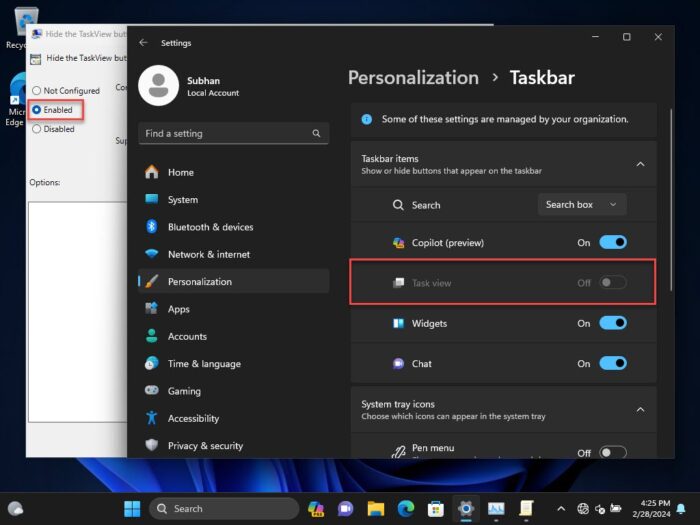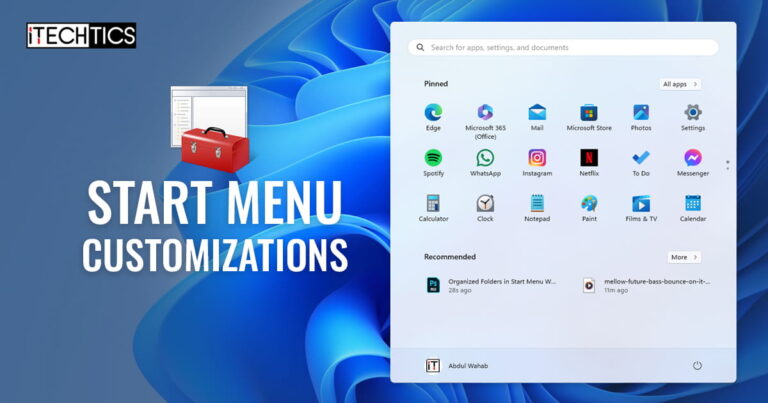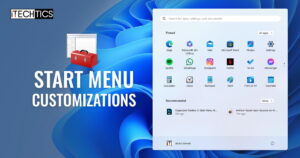Key Points
- To manage the Start menu, go to Settings > Personalization > Start, but you get limited options here.
- To customize the Start menu using Group Policies, open the Group Policy Editor and go to Computer Configuration > Administrative Templates > Start Menu and Taskbar.
The Start menu is available on the taskbar as soon as you sign in on the Windows operating system was first launched with Windows 95. It has since been included in all the following operating systems. However, Microsoft has been upgrading its interface as well as its functionality.
When Microsoft released the original Windows 11 OS, the location and the layout of the Start menu were one of the most significant changes, when compared to Windows 10 and older operating systems. Moreover, the new Start menu provided more customization and management options, which can be found in Settings > Personalization > Start.

Even with these options, the customization requirements may not be enough for some users. This is why Microsoft has given further customization options with Group Policies. Group Policies define the rules and regulations defined by the system or domain administrator.
Since these Group Policies for the Start menu were designed for older operating systems, some of them may not work as intended with Windows 11. However, after having tested them out, I can assure you that they do not interfere with the operating system’s stability and functionality in any way.
This guide discusses how you can customize the Start menu using the given Group Policies, and what each of them does.
The Windows 11 Start menu

By default, the Windows 11 Start menu looks like the one in the image above. As you can see, it has a “Pinned” section, which shows the pinned apps that can be managed, and a “Recommended” section, which shows the apps and programs based on your previous app activity.
Additionally, you also have an “All apps” button in the top-right corner of the menu that shows all apps and programs on the PC in alphabetical order.

Now, from the Settings app, you can manage whether more pinned apps are shown, or more recommendations, or leave it as the default setting. Moreover, you can also manage certain behaviors of the Start menu, such as showing recently added apps, most used apps, recently opened items, etc. Moreover, you can also show direct links to folders to appear alongside the power icon at the bottom.
That said, these are the only options that the Start menu settings provide. However, the Start menu Group Policies provide more customization options, which I have discussed below.
Customize Start menu with Group Policies
The Group Policy Editor in the Windows 11 OS provides several Group Policies to customize the Start menu so you can set it up as you like it. Moreover, it gives you more control over what options should and shouldn’t be available in the Start menu.
Inside the Group Policy Editor, you can find the policies for the Start menu at the following path:
Computer Configuration > Administrative Templates > Start Menu and Taskbar
To open the Group Policy Editor, you can type in “gpedit.msc” in the Run Command box and press Enter.

As you can see, the Group Policy Editor provides several policies to customize the Start menu. We will go through each of these below in detail so you know how to use them.
Note: After configuring each policy, you must either restart “explorer.exe” or restart the computer for the changes to take effect.
-
Disable context menus in the Start Menu

Context menu in the Start menu The context menu in the Start menu provides several options to the user, such as running the app with elevated privileges, uninstalling an app, etc. With this Group Policy enabled you can remove the context menu completely when a user right-clicks on any icon in the Start menu.
-
Disable Editing Quick Settings
This Group Policy does not affect the Start menu, but the taskbar. More precisely, it affects the Quick Settings menu that is available when you click the battery/Wi-Fi icon on the right side of the taskbar.

Quick Settings options grayed out When enabled, certain options are grayed out, and some do not work when toggled. However, this policy does not work perfectly on Windows 11 and still needs some work.
-
Force Start to be either full screen size or menu size
This policy lets you change the size of the Start menu to full screen, as it was in Windows 8 (only a bit better).
When enabling this policy, you must also define the size of the Start menu to keep, and users will be unable to change it in the Settings.

Resize the Start menu from the Group Policy Having said that, I noticed that this policy did not work on my Windows 11 PC, and perhaps this is what Microsoft meant when they said that “some policies may not work as expected”.
-
Remove and prevent access to the Shut Down, Restart, Sleep, and Hibernate commands
Enabling this policy prevents users from accessing the power options inside the Start menu. The button is still there, but when a user clicks on it, it will display the following:
There are currently no power options available.

Power options in Start menu not available -
Remove “Recently added” list from Start Menu
This policy does precisely what its name suggests. Enabling this policy will no longer show the icons for the apps that you install inside the Start menu.
-
Remove Personalized Website Recommendations from the Recommended section in the Start Menu
Enabling this policy will stop showing recommended websites in the Start menu. These are the websites that you frequently visit, or have opened recently.
-
Remove Recommended section from Start Menu
The Recommended section in the start menu shows the items that you recently accessed, including files and folders. By default, this section covers nearly half of the Start menu.
Enabling this Group Policy will remove this section, and the Start menu will then only show the content that is allowed, like the pinned apps.
That said, after testing this policy, I found that it does not work on the latest builds of Windows 11, and the Recommended section remained.
-
Start Layout
This policy lets you change the layout of the Start menu using an XML file. After enabling this policy, you must also provide the path of an XML file to apply the layout changes. Optionally, you can also select the option to “Reapply layout at every logon“.

Configure Start menu layout using Group Policy and XML file To use an XML file for the Start menu layout, you can export it from a computer by running the following command in PowerShell:
Export-StartLayout -UseDesktopApplicationID -Path C:\layout.xmlOf course, you can set your own path and file name. When exported, you may use the generated XML file on another computer to use the same Start menu layout.
-
Remove frequent programs list from the Start Menu
As the name suggests, enabling this policy will stop the frequently-used apps and programs from appearing in the Recommended section.
-
Remove All Programs list from the Start menu
This Group Policy affects the behavior of the “All apps” button in the Start menu. It provides several different settings for this button. Here are the options you can choose from when this policy is enabled:
- None – makes no changes
- Collapse – Does not show the app list in the start menu, but only shows the “All apps” button. (this makes no changes for Windows 11 as this is already the default setting).
- Collapse and disable setting – Does not show the app list in the start menu, but only shows the “All apps” button. Also, it disables the “Show app list in Start” option in the Settings app, which already doesn’t exist in Windows 11. Therefore, make no changes to the Start menu.
- Remove and disable setting – Removes the “All apps” button in the Start menu next to the pinned apps.
After having tested each of these policy configurations, it can be said that the only useful configuration is enabling the “Remove All Programs list from the Start menu” policy and selecting “Remove and disable settings“, which will remove the “All apps” button from the Start menu.

“All apps” button is removed -
Do not keep history of recently opened documents
Enabling this policy prevents the Start menu from displaying the accessed documents in the Recommended section. Moreover, the recently or frequently used files, folders, or websites also do not appear.
Everything is removed from here which was accessed while the policy was enabled.
-
Remove Run menu from Start Menu
This policy applies to the older Windows operating system that could open the Run Command box from the Start menu. Since the option was later removed, it is of no use in Windows 11.
-
Prevent changes to Taskbar and Start Menu Settings
This policy prevents users from making changes to the Start menu or the taskbar. This means that they cannot change their behavior. However, they will still be able to manage the pinned apps and recommended apps, like uninstalling them, unpinning them, etc.
When this policy is enabled, some of the settings to manage the taskbar and the Start menu are also grayed out.

Unable to make changes to the Start menu -
Remove access to the context menus for the taskbar
This policy applies to the taskbar and not the Start menu. Just like “Disable context menus in the Start Menu“, enabling this policy prevents the context menu from opening on the taskbar.
-
Prevent users from uninstalling applications from Start
Enabling this policy removes the “Uninstall” option from the context menu in the Start menu. This way, users will no longer be able to uninstall the apps directly from the Start menu.

Uninstall option removed from context menu in Start -
Show or hide “Most used” list from Start menu
This policy lets you show or hide the most used apps in the Recommended section inside the Start menu. After enabling the policy, you must also configure it. For that, you can choose either “Show” or “Hide” from the options.
Selecting Show will force the most-used apps to appear in the Start menu, and selecting Hide won’t show them.
Moreover, when this policy is enabled, the “Show most used apps” setting in Settings > Personalization > Start will be grayed out, and users will not be able to manage it themselves.

Show or hide most used apps in Start menu -
Simplify Quick Settings Layout
This policy applies to the Quick Settings menu.
When this policy is enabled, the Quick Settings menu is reduced to only the fundamentals, which include Wi-Fi, Bluetooth, Accessibility, and VPN settings.

Simplify Quick Settings menu -
Pin Apps to Start when installed
Enabling this policy will automatically start pinning the app icons to the “Pinned apps” section as soon as they are installed.
-
Hide the TaskView button
Again, this policy does not apply to the Start menu, but it does to the taskbar. If this policy is enabled, users will no longer see the “Task View” button in the taskbar. Moreover, they will also not be able to manage the Task View toggle in Settings > Personalization > Taskbar as it will be grayed out.

Task view button is disabled in taskbar -
Removed pinned programs from the Taskbar
This policy applies to the taskbar as well. When enabled, the pinned app icons won’t be displayed in the taskbar. Moreover, users won’t be able to pin any apps either.
However, the default applications managed from Settings > Personalization > Taskbar will still appear.
Closing words
The Start menu can be your go-to place to access your most frequent apps, files, and folders. You can manage its layout and configure it according to your usefulness through the Group Policies discussed in this post, and maximize your productivity while using a Windows PC.



